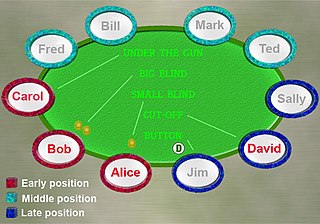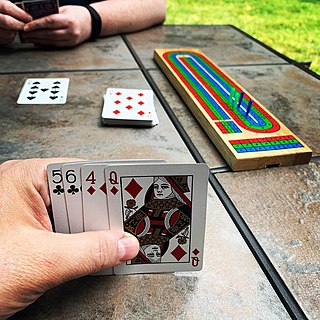
Sternhalma, commonly known as Chinese checkers or Chinese chequers, is a strategy board game of German origin that can be played by two, three, four, or six people, playing individually or with partners. The game is a modern and simplified variation of the game Halma.

Tic-tac-toe, noughts and crosses, or Xs and Os is a paper-and-pencil game for two players who take turns marking the spaces in a three-by-three grid with X or O. The player who succeeds in placing three of their marks in a horizontal, vertical, or diagonal row is the winner. It is a solved game, with a forced draw assuming best play from both players.

In the game of poker, the play largely centers on the act of betting, and as such, a protocol has been developed to speed up play, lessen confusion, and increase security while playing. Different games are played using different types of bets, and small variations in etiquette exist between cardrooms, but for the most part the following rules and protocol are observed by the majority of poker players.

Cribbage, or crib, is a card game, traditionally for two players, that involves playing and grouping cards in combinations which gain points. It can be adapted for three or four players.

In the United States and Canada, bingo is a game of chance in which each player matches the numbers printed in different arrangements on cards. The game host draws balls at random, marking the selected numbers with tiles. When a player finds that the selected numbers are arranged on their card in a horizontal, vertical, or diagonal line, they call out "Bingo!" to alert all participants to a winning card, which prompts the game host to examine the card for verification of the win. Players compete against one another to be the first to have a winning arrangement for the prize or jackpot. After a winner is declared, the players clear their number cards of the tiles and the game host begins a new round of play.

Primero, is a 16th-century gambling card game of which the earliest reference dates back to 1526. Primero is closely related to the game of primo visto, if not the same. It is also believed to be one of the ancestors to the modern game of poker, to which it is strikingly similar.

Thirty-one or Trente et un is a gambling card game played by two to seven people, where players attempt to assemble a hand which totals 31. Such a goal has formed the whole or part of various games like Commerce, Cribbage, Trentuno, and Wit and Reason since the 15th century. 31 is popular in America and Britain.

Carrom is a tabletop game of Indian origin in which players flick discs, attempting to knock them to the corners of the board. The game is very popular in the Indian subcontinent, and is known by various names in different languages. In South Asia, many clubs and cafés hold regular tournaments. Carrom is commonly played by families, including children, and at social functions. Different standards and rules exist in different areas. It became very popular in the United Kingdom and the Commonwealth during the early 20th century.It became very popular in the United Arab Emirates and the rest of the Persian Gulf and the Arabian peninsula during the Arab- Indian spice trade until this day

Tag is a playground game involving one or more players chasing other players in an attempt to "tag" and mark them out of play, usually by touching with a hand. There are many variations; most forms have no teams, scores, or equipment. Usually, when a person is tagged, the tagger says, "It!" or "Tag, you're 'It'!". The last one tagged during tag is "It" for the next round. The game is known by other names in various parts of the world, including "running and catching" in India and "catch and cook" in the Middle East.
itbox is a networked gambling games terminal which is found in thousands of pubs, leisure centres and amusement arcades in the United Kingdom. Classified as a "skill with prize" (SWP) machine, each itbox terminal typically includes 25 different games. Each game costs 50p or £1 to play and lasts between 10 seconds and several minutes. From most of these games it is possible to win modest cash prizes. Although strictly the name 'itbox' refers only to Leisure Link-made terminals, the name is often casually applied as a genericized trademark to other SWP terminals such as Paragon SWP, Gamesnet, ind:e and Fatbox.

Bouillotte is an 18th-century French gambling card game of the Revolution based on Brelan, very popular during the 19th century in France and again for some years from 1830. It was also popular in America. The game is regarded as one of the games that influenced the open-card stud variation in poker. The rules continue to be printed in French gaming compendia.
The following is a glossary of traditional English-language terms used in the three overarching cue sports disciplines: carom billiards referring to the various carom games played on a billiard table without pockets; pool, which denotes a host of games played on a table with six pockets; and snooker, played on a large pocket table, and which has a sport culture unto itself distinct from pool. There are also games such as English billiards that include aspects of multiple disciplines.

Pichenotte refers to a family of several disk-flicking games, mostly French Canadian in origin, including crokinole, pitchnut, and North American carrom, which may sometimes be played with small cue sticks. Pichenotte is a Canadian French word meaning 'flick', which is derived from the European French word pichenette, also meaning 'flick'. These folk games are in the public domain, and are not subject to copyright like a commercial board game. Nor are they patented games. However, the names Pichenotte and Pitchnut are registered trademarks in the United States. The game community site Knipsbrat.com states that, like the German name Knipsbrat ('flicking-board'), "pichenotte is another name for crokinole" The Canadian game board collection at the Quebec Museum of Civilization in Quebec City includes both the square carrom-type board and the round crokinole-type game Crokinole is also called pichenotte throughout much of North America. Modern-day tournaments have been held as far apart as Tavistock, Ontario, and Santa Fe and Albuquerque, New Mexico.
Traditional Filipino games or indigenous games in the Philippines are games that are played across multiple generations, usually using native materials or instruments. In the Philippines, due to limited resources for toys, children usually invent games that do not require anything but players. There are different kinds of Filipino traditional games which are well-suited for kids, and the games also stand as one of the different cultural and traditional games of the Philippines. Due to the variety of skills used in these games, they serve an important purpose in the physical and mental development of Filipino children. These games are also an important part of Filipino culture.
There have been a variety of Sesame Street video games released for video game platforms. Most of the Sesame Street video games were published and developed by NewKidCo.
The following is a glossary of poker terms used in the card game of poker. It supplements the glossary of card game terms. Besides the terms listed here, there are thousands of common and uncommon poker slang terms. This is not intended to be a formal dictionary; precise usage details and multiple closely related senses are omitted here in favor of concise treatment of the basics.
Stud poker is any of a number of poker variants in which each player receives a mix of face-down and face-up cards dealt in multiple betting rounds. Stud games are also typically non-positional games, meaning that the player who bets first on each round may change from round to round. The cards dealt face down to each individual player are called hole cards, which gave rise to the common English expression ace in the hole for any hidden advantage.

Duck, duck, goose is a traditional children's game often first learned in preschool or kindergarten. The game may be later adapted on the playground for early elementary students. The object of this game is to walk in a circle, tapping on each player's head until one is finally chosen; the chosen player must then chase the picker to avoid becoming the next picker.

The following is a glossary of terms used in card games. Besides the terms listed here, there are thousands of common and uncommon slang terms. Terms in this glossary should not be game-specific, but apply to a wide range of card games played with non-proprietary packs. It should not include terms solely related to casino or banking games. For glossaries that relate primarily to one game or family of similar games, see Game-specific glossaries.












